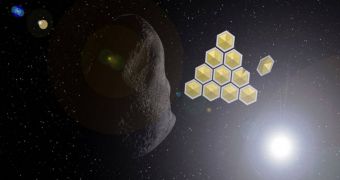According to a proposal made earlier this year at a scientific conference, it may be that one of the most effective ways of changing the path of dangerous asteroids that may beheading our way would be to deploy solar sails to nudge them off-course.
On May 21 of this year, the Japanese Aerospace Exploration Agency (JAXA) launched the Akatsuki Venus climate orbiter, a spacecraft that eventually overshot its target and failed to reach orbit.
Also on the H-IIA delivery system that launched the satellite was the IKAROS solar sail demonstrator, which became the first ever to show beyond a doubt that it's possible to move forward and steer in space using nothing by sunlight.
Now that we know solar sail technology is viable, experts are beginning to think of possible uses for it beyond powering spacecraft. They say that diverting asteroids might also be on the table.
Scientists participating at a solar sail symposium held at the New York City College of Technology in Brooklyn some months ago said that the new approach could be used against the asteroid Apophis, which will pass very close to our planet on April 13, 2036.
At this point, there is no reason to believe that the rock will slam into our planet, but astronomers say that the asteroid will pass too close for their comfort. As such, shading the space rock from solar radiation with sails could be applied here.
However, there are those who believe that messing about with the asteroid might make its approach even more dangerous than it is now. But the French expert who proposed the mission at the meeting says that using solar sails poses no threat.
“Apophis is a nice target for launching this kind of mission for 20 years from now; not too far, not too close,” says National Center for Space Study (CNES) engineer Jean-Yves Prado.
He explains that the path the asteroid takes could be influenced by a flotilla of solar sail spacecraft, which would eliminate the Yarkovsky effect on the space rocks.
The effect was discovered about 100 years ago, by Russian engineer I.O. Yarkovsky, and it takes place when the Sun warms a space rock more on one side than the other, Space reports.
As his happens, the asteroid begins emitting thermal radiation, which produces a little bit of thrust. Its momentum is then slightly changed, as is its trajectory.
If solar sails block solar radiation, then there would be no Yarkovsky effect, and the asteroid would leave its current trajectory. Given the time we have until Aphophis comes, this should be easy to do.
“It's really a very small effect and doesn't apply to very small asteroids because the temperature would be quite negligible, so thrust is negligible,” Prado says.
“It also does not apply to very large asteroids because they are too heavy,” he goes on to say, adding that Apophis is right in the middle category, meaning the effect influences it considerably.

 14 DAY TRIAL //
14 DAY TRIAL //